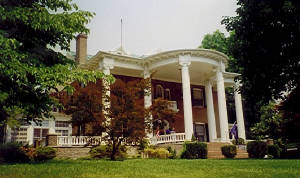|
The Beta Xi Chapter
developed from a group of independent girls seeking national sorority affiliation. The Beta Xi chapter became officially affiliated
with Sigma Sigma Sigma National Sorority on May 11, 1951, making Tri-Sigma the first national sorority on the Southeast campus.
The Beta Xi Chapter celebrated our 50th year Anniversary on April 28, 2001.
Charter members
included: Lucille Dede, Barbara Bess, Joan Lorenz, Ann Proffer, Pat Wilson, Louise Remley, Bobbye Hardin, Pamela Richards,
Dorothy Meek, Edith Howe, Mary Gregary, Jo Ann Hediger, Peggy Glenn, Judy Wasco, Eva Manche, Helen Parker, Margaret Neuman,
Louis Kinder, and Nan Hurley.
In the last
50 years, the Beta Xi women have accomplished many great feats and have helped produce many fine leaders for the national
organization and society. Southeast’s Tri-Sigma’s are proud to boast the “Legacy of Leadership” as
their local slogan.

|
 |
|
|
|
 |
 |
 |
|

Mabel Lee Walton House
Many things
now taken for granted were unheard of for the women of the 1890s. Higher education for women was still a debatable topic,
but the need for qualified teachers was high. In Virginia, the State Female Normal School at Farmville was the state's first
institution to open its doors for teacher education. Now known as Longwood College, this is where brave, 15-17 year-old women
came to prepare for the teaching profession, rather than accept the social custom of being sheltered and tutored in their
own homes. These trend-setting women at Farmville made their school the birthplace of four national sororities; one was Sigma
Sigma Sigma
Tri Sigma's eight founders, Margaret Batten,
Louise Davis, Martha Trent Featherston, Isabella Merrick, Sallie Michie, Lelia Scott, Elizabeth Watkins, and Lucy Wright,
formed a special friendship at the Normal School. Lucy Wright and Lelia Scott led the first meetings of the S.S.S. Club in
1897. They announced the founding of Sigma Sigma Sigma on April 20, 1898.
The early
Tri-Sigmas saw the need for both legal recognition as a social body and a written record of organization. Thus the early Alphas
filed documents with the Commonwealth of Virginia and Sigma Sigma Sigma received its Charter of Incorporation on February
12, 1903. The Alpha Chapter adopted Tri Sigma’s first constitution in April 1903. One prominent man in Tri Sigma's early
history was J. Miller Leake, the only man given the privilege of wearing the indented triangle badge. A member of Kappa Sigma
at Randolph-Macon Men's College, he wrote the Sorority's initiation ritual, helped revise the Constitution and assisted in
writing the lyrics to Stately and Royal. Giant steps were taken in Sigma's first decade with the establishment of additional collegiate chapters and
the meetings of the entire membership at Conventions. The national nature of Tri Sigma was established with the Publication
of The Triangle, the standardization of a ceremony for new members and the creation of a program to celebrate Founder's Day.
The circle of friendship that began in the 1890s, with eight women sharing common experiences, now encompasses more than 70,000
women representing the diversity found on the college campuses of today. The growth and change that occurred in the many decades
to follow always stayed true to the ideals of friendship espoused by the Founders
|
 |
|
|
|



